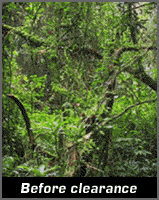Our Environment Contents
2. Impacts
Forest clearance

In the past, and still now in some areas, forests have been treated as dispensable resources, with insufficient regard for the critical ecological functions which they provide. Tropical rainforests, for example, perform photosynthesis throughout the year, removing carbon dioxide (the most important anthropogenic greenhouse gas) from the atmosphere by storing it as carbon in the form of wood. They also play a vital role in the recycling of oxygen throughout the global ecosystem. Yet schemes for development of those forested areas too often entail their destruction in order to secure short term economic gain, thereby jeopardising the global ecosystem in the longer term. Also, given that tropical soils are low in mineral nutrients, and their minerals are prone to rapid leaching, if the vegetation is destroyed there is no means of trapping and recycling those minerals and nutrients.
Forest clearance can also expose soils to wind and rain, eroding and eventually removing them. This leads to increased water runoff from rain, with water flowing downhill rather than sinking into the soil. This can lead to increased flooding.
In what ways can forest clearance be environmentally harmful?